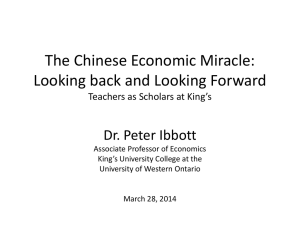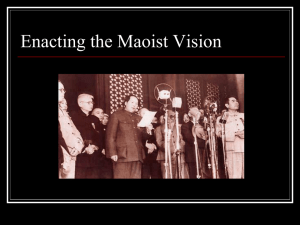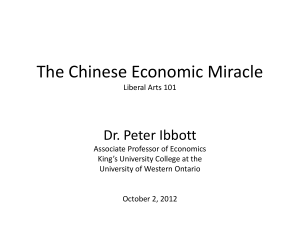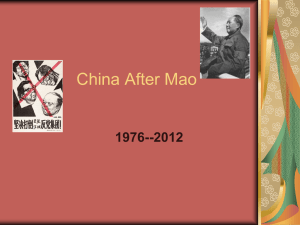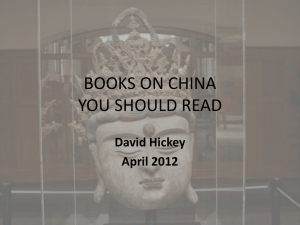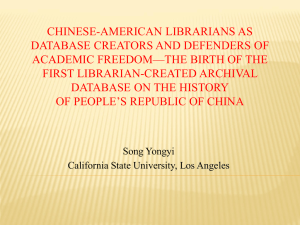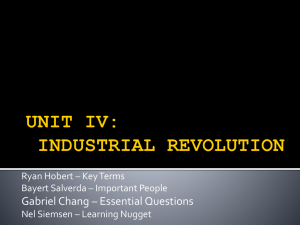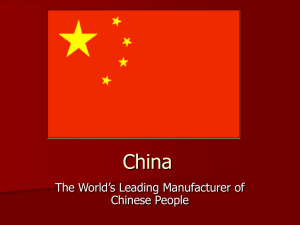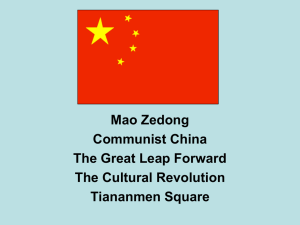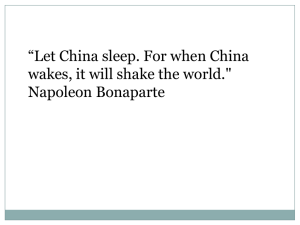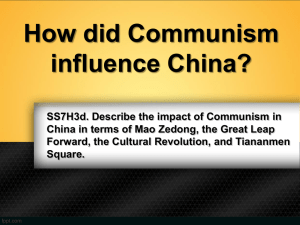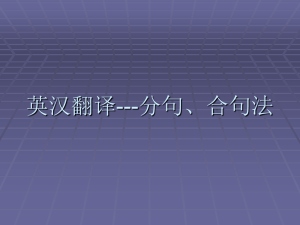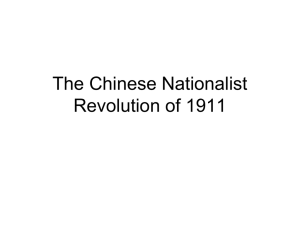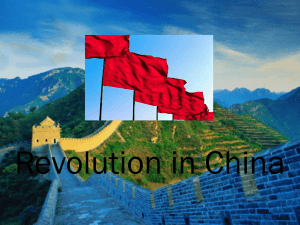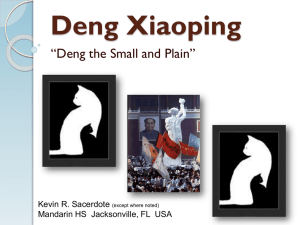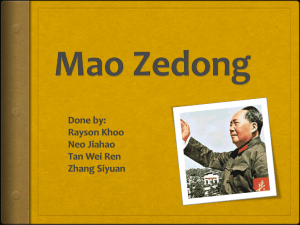ChineseEconomicMiracle_India
advertisement
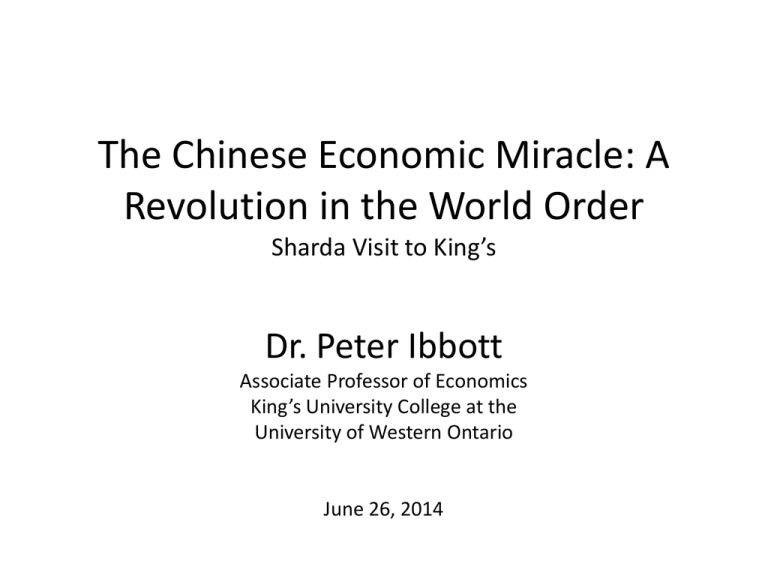
The Chinese Economic Miracle: A Revolution in the World Order Sharda Visit to King’s Dr. Peter Ibbott Associate Professor of Economics King’s University College at the University of Western Ontario June 26, 2014 Readings: • “China 2030: Building a Modern, Harmonious, and Creative High-Income Society” • • published by the World Bank and available at http://www.worldbank.org/en/news/2012/02/27/china-2030-executivesummary • “Is China Overinvesting and Does it Matter” • • Published by the IMF and available at https://www.imf.org/external/pubs/ft/wp/2012/wp12277.pdf • “Supersized cities: China’s 13 megalopolises “ • • published by the Economist and available at http://www.eiu.com/Handlers/WhitepaperHandler.ashx?fi=Megalopolis_Report_ July_2012.PDF&mode=wp&campaignid=Megalopolis2012 • “2013 Human Development Report” • • Published by the World Bank and Available at http://hdr.undp.org/en/data Shanghai: Bund Shanghai: Pudong The Chinese Economic Miracle: A Revolution in the World Order • China’s rise is rebalancing power and influence in the world. • The rate of change is unprecedented in human history, and this raises many important questions, but not very many good answers. – Why has this change happened? – Will it continue? – Is this change making life better for ordinary people in China? – Are there other countries who are rising with China? – Is this change truly revolutionary? Is this change truly revolutionary? 2011 Nominal GDP in US$ billions (Source: IMF) Vehicle sales 2007-2012 Pork consumption Pork has long been the most popular meat in China, but consumption was traditionally limited by the weak spending power of most of the population. As people's incomes have risen strongly since the 1990s so the amount of pork purchased has soared. China 1990 310 million 2010 666.9 million US 1990 85.4 million 2010 110.4 million Basic Education • 1950: 20% over age 15 are literate • 2007: 93.3% over age 15 are literate while 99% of 15-24 year olds are literate • 2009, PISA (Program for International Student Assessment) international rankings of 15 year olds placed Shanghai students first in the world in mathematics, science and literacy Health • 1949: Average Life Expectancy of 35 years • 2012: Average Life Expectancy of 74.8 years • But life expectancy would be much higher if respiratory illnesses (cigarettes, air pollution) could be reduced, water quality improved and food safety increased. • Improvements to public health should provide huge gains in life expectancy. Is this change making life better for ordinary people in China? • Revolutionary Change has provided ordinary people both benefits and costs. • Benefits: – Longer Lives – Better Education – Falling Poverty Is this change making life better for ordinary people in China? Costs • Rising Inequality • Pollution • Congestion • Corruption • Consumerism – Endless pursuit of status goods – Rising Search for spiritual alternative (Christianity is growing very fast) – Vice (drugs, gambling, prostitution) is a rising menace. – Congestion • Overpopulation Culture does not determine inequality. • • • • • Canada: Gini = 32.1 Korea: Gini = 31.4 Taiwan: Gini = 34.2 Peoples Republic of China: Gini = 41.5 Hong Kong: 53.3 Politics and economic policy matters!!! Pollution: Economic cost to the environment (2011) 100-km Chinese traffic jam enters Day 9 Last Updated: Monday, August 23, 2010 | 1:43 PM ET CBC News External Links Xinhua: Highway jam enters its 9th day, spans 100km (Note: CBC does not endorse and is not responsible for the content of external sites - links will open in new window) (David Gray/Reuters) A nine-day traffic jam in China is now more than 100 kilometres long and could last for weeks, state media reported Monday. Thousands of trucks en route to Beijing from Huai'an in the southeast have been backed up since Aug. 14, making the National Expressway 100 impassable, Xinhua News reported. A spokesman for the Beijing Traffic Management Bureau reportedly told China's Global Times newspaper that the backup was due to "insufficient traffic capacity … caused by maintenance construction.“ The construction is scheduled to last until Sept. 13.Stranded drivers appear to have few options when it comes to dealing with the jam. At least some drivers have complained that roadside vendors have increased their prices to take advantage of the traffic jam. One truck driver said he bought instant noodles from one vendor for four times the original price. Q: Is growing prosperity contributing to the overpopulation problem? Overpopulation • One child policy introduced in 1978 (Deng Xiaoping) has caused a number of unintended consequences of enormous significance: – Increased the proportion of males to females – Encouraged the state to use its power to violently intervene in the most important decisions made by ordinary families. – Has caused China to have a rapidly aging population which will soon increase the dependency ratio and further weaken the already weak social safety net – Will put increasing pressure on the health care industry and further reduce access to primary health care for most ordinary Chinese families. China’s Population • • • • • • • • • • • • 2 AD: 86,000,000 1000: 87,000,000 1500: 110,000,000 1800: 260,000,000 1900: 400,000,000 1950: 546,815,000 1982: 1,008,065,000 (reaches 1 billion) 2010: 1,337,825,000 (almost 1 in 5 people live in China) 2020: 1,387,792,000 2030: 1,393,076,000 2040: 1,360,906,000 2050: 1,295,604,000 Q: Where do all these people live? Population Density Rural-urban migration is a much more powerful force than population growth. The result has been the rise of super-megalopolises • Guangzhou: ≈ 41 million • Beijing-Tianjin : ≈ 30 million • Shanghai: ≈ 25 million Q: What do all these people want? • Middle class lifestyle: – Car (already world’s largest automobile market) – TV, Internet, Music, Movies, Mobile phones • http://www.youtube.com/watch?v=9bZkp7q19f0 – Consumer goods • Global brands are coveted – Status recreational activities – Quality Education in the Arts and Science – Home ownership Q: What Caused the Chinese Economic Miracle? Mao’s Revolution caused Economic Stagnation 1949-58: Mao consolidates power • encourages families to have more children • introduces China’s first five year plan based on the Soviet model • the “Commanding Heights” of the economy are to be seized by large state monopoly firms pursuing heavy industrial development. Mao’s Revolution and Stagnation 1958-61: Mao abandons the soviet industrial development model for “The Great Leap Forward” to “grass-roots” or agrarian socialism. Policy turns away from the commanding heights towards rural development. • Small rural agricultural collectives were merged into large, rural “People’s Communes” in order to better exploit the gains from the division of labor. • The People’s Communes: – Banned all private holdings/gardens – Introduced new farming techniques that would turn China into a grain exporter – Accelerated the construction of state infrastructure, – Increased steel production by using backyard furnaces. Mao’s Revolution and Stagnation 1959-61: “The Great Leap Forward” begat the “Great Chinese Famine” where between 18 - 45 million died of starvation, while 200 million suffered from serious malnutrition. During this time, China exported grain. 1961-65: The failure of the Great Leap Forward causes the party to force Mao into a ceremonial role within the party. • Leadership of Economic Policy is assumed by Liu Shaoqi and Deng Xiaoping. • They reversed the Great Leap Forward by breaking up the People’s Communes. • Deng famously argues that "It doesn't matter whether it's a white cat or a black, I think; a cat that catches mice is a good cat." Mao’s Revolution and Stagnation 1966-76: Mao encourages the Cultural Revolution and uses it to purge Liu Shaoqi, Deng Xiaoping, and other leaders of the CPC who had earlier opposed him. • The Red Guards are placed at the vanguard of class struggle against “right leaning elements” who had resisted agrarian socialism. • Grass-roots revolutionaries go on a campaign to identify and purge perceived enemies of the new order through campaigns of forced self criticisms and re-education through labor. • The aims of the cultural revolution expanded to shift power out of the cities to the grass-roots people’s collectives. • Works of historical and cultural value are destroyed because they were thought to be at the root of "old ways of thinking". An Economic Revolution Begins • Mao dies in 1976. Hua Guofeng is Mao’s anointed successor. He takes power and moves quickly to marginalize extremist elements within the party. The Gang of Four are arrested and the cultural revolution ends. • 1976-80: Deng Xiaoping consolidates his power in the party and quietly pushes Hua Guofeng into retirement. The transition is peaceful. • 1978: Deng introduces significant economic reforms aimed at introducing “market socialism” under a new banner “Socialism with Chinese Characteristics”. The Chinese Economic Miracle Economic Revolution: Stage 1 (1978-84) • De-collectivization of agriculture, and the introduction of the “household responsibility system”. Farmers are granted long term leases and allowed to privately farm and sell their produce in new private markets. • Agricultural output growth dramatically accelerated to 8.2% a year, agricultural prices fell, meat and vegetable production rose dramatically. • Special Economic Zones were created that permitted foreign investment and encouraged local entrepreneurs to start up businesses. • But: most industry remained state-owned. The Chinese Economic Miracle Economic Revolution: Stage 2 (1985-2010) • the privatization and contracting out of much state-owned industry • lifting of price controls, protectionist policies, and regulations, • But: state monopolies in sectors such as banking and petroleum remained. • But: The conservative Hu Jintao Administration more heavily regulated and controlled the economy after 2005, reversing some reforms. The Chinese Economic Miracle Impact of Economic Reforms • Overall the reforms unleashed economic growth that is unprecedented in human history – GDP Growth rate of 9.5% a year – China's economy became the second largest after the United States. – More than 500 million people lifted out of poverty – Now the world’s largest exporter and manufacturer – In transition from middle-income to high-income status. The Chinese Economic Miracle Why did the economic reforms work? • The sources of economic growth are: – Growth in the Labour Supply – Growth in Capital – Growth in Productivity • Growth in GDP per capita requires – Capital Deepening (K has to grow faster than L) – Total Factor Productivity has to rise • The reforms to agriculture and the introduction of private enterprise increased the productivity early in the process • Later reforms encouraged a high savings rate while encouraging private investment by domestic and foreign enterprise. The Chinese Economic Miracle Will the miracle of high growth continue? • As the process continues, limits to growth begin to assert themselves • Labour growth will decline because of the a stagnant population and the reduced flow of rural migrants to the cities. • Productivity growth will begin to slow as technology in China catches up to leading economies. – The Law of Convergence. • Capital growth has fueled the last 15 years of growth, and this is not sustainable. The Chinese Economic Miracle Why are high levels of investment unsustainable? • Micro studies of firms show evidence of over-investment by State Owned Enterprises (SOE’s) and many private enterprises. • China’s banking system is biased towards SOE’s and many of these are very vulnerable to defaulting on their debt if there is a downturn in demand. • Much of China’s investment has been directed at the housing sector and there is considerable evidence of a speculative bubble in prices and over-supply in the housing stock. • Over the last 10 years, the capital-output ratio has risen faster and higher than levels seen in other developing countries. At the same time there has been a fall in the return to capital. Eventually a tipping point will be reached. A rapid adjustment could cause confidence to collapse triggering a financial crisis, recession and a potentially very hard landing. Two questions: 1. Can China’s growth rate still be among the highest in the world even if it slows from its current pace? 2. Can it maintain this rapid growth with little disruption to the world, the environment, and the fabric of its own society? The World Bank report answers both questions in the affirmative, i.e., by 2030, China has the potential to be a modern, harmonious, and creative high-income society. Achievable but neither certain nor easy. What are the risks and challenges? 1. Internal Risks and Challenges • depletable resources • demand-pull and supply-push inflation • demography, aging population • pace of human capital accumulation 2. External Risks and Challenges • global economic slowdown • high resource prices • new emerging competitors What does China need to do? The IMF Report argues that China must implement a NEW long term strategy for the next phase of development. This strategy should: 1. Complete the transition to a market economy 2. Accelerate the pace of open innovation 3. Go green 4. Expand Individual Opportunities and Improve Social Services 5. Fiscal Reform 6. Become a responsible Global Player Substantial hurdles ahead: • Challenges posed by an ageing and shrinking workforce, • Rising inequality, • Environmental stresses, and • External imbalances and shocks. • Brittle Political System Are there other countries who are rising with China? • Much attention has been paid to the BRIC countries as an emerging new base of economic and political power • The evidence suggests that Brazil, India and Russia are unlikely to experience the same level of revolutionary change as China. • The stakes are highest for India. China and India Compared: GDP per Capita Source: IMF An Indian Revolution? • Average Per Capita Incomes in Purchasing Power Parities crossed more recently, but there is a growing gap (China and India). • But India is slowly closing the gap on life expectancy (China and India). An Indian Revolution? • India is noticeably trailing China in Education and Poverty Alleviation • Development and Education • Development and Poverty • But is not yet as unequal as China. In particular, the poor have a more meaningful impact on political decision-making in India. An Indian Revolution? • While the Indian political system is much more resilient and more representative than China’s, it has been difficult for India to make the changes necessary to experience the same revolutionary change as China. • India is in the unenviable position of falling behind China, while facing the same costs of growth. Population growth is a more serious problem for India because of the failure to launch an economic revolution. • The big question is whether India is politically able to develop policies that both encourage growth and ameliorate the costs of growth?
